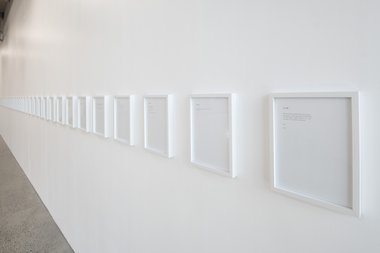John Hurrell – 29 February, 2024
The viewers hold an image (or activity) in their mind generated by words, instead of pondering photographs, drawings or objects in the gallery space, but that image (or activity) is in a sense beholden to the brief text (its semantic content and formal attributes like font size and paragraph placement) typed onto a framed (in white) and glassed over piece of paper. It is one of many: 92 in fact.
Auckland
Ken Friedman
92 Events
8 December - 28 March 2024
Toured by Adam Art Gallery Te Pātaka Toi
Let’s talk about the Friedman survey exhibition at Ngutu Kākā, in Gallery One, toured by the Adam. Ken Friedman‘s Fluxus proposed works (not necessarily executed—the described instructions alone is sufficient to give them art status) were made as written ideas or ‘scores’ from 1956 to 2019, beginning long before Yoko Ono met John Lennon. The gallery visitor focusses on reading more than looking (for that experience is deliberately excruciatingly bland), and you might argue, imagining more than thinking about physical presence within ‘white cubed’ ‘art friendly’ architecture. Being fixated on small-fonted text (the visual equivalent of a whisper), they straddle both Conceptual Art and Fluxus.
The viewers experience holding an image (or activity) in their mind generated by words, instead of pondering photographs, drawings or objects in the gallery space, but that image (or activity) is in a sense beholden to the brief text (its semantic content and formal attributes like font size and paragraph placement) typed onto a framed (in white) and glassed over piece of paper. It is one of many: 92 in fact.
These are in a long row swooping around the walls—optically merging with the white glare of the wide gallery planes. You have to stand very close to read the texts. If you wish to perform them at all. Or mentally picture such activity.
A particular taste and interest in avant-garde art history is needed to find them interesting. If you believe that the idea is the main point, that that aspect is interesting and that these happen to be exciting examples. There is also another argument (a countering view) that this show is a waste of time as an exhibition, that it is dull (no visual ‘carrot’ to draw you in), and that in terms of public access, its content would probably reach an audience more effectively as a book with its sequence of pages indicating chronology. Getting in on ‘the art exhibiting circuit’ however means the advantages of CV burgeoning and enhancing career profile. Attendance numbers don’t matter.
Besides, today articles like the one you are now reading extend the impact of the exhibition—perhaps replace it—pushing it digitally into domestic and institutional spaces with readers’ homes, workplaces and modes of transport. Particularly with links like this, this and this. Your body doesn’t have to be positioned in close proximity to the framed physical results of Friedman’s mental (and possibly manual) labour, placed in an art-ordained academic institution, to get the drift of his practice, though there may be clear benefits through examining its detail in compositional layout and language type personally. (Analysing its hazily calculated vagueness: minimal skeletal description.)
Ngutu Kākā is easy to get to.
John Hurrell
Recent Comments
Ralph Paine
Hickey’s renegade aesthetic turn is sooooo late 20th century American, sooooo chain smoking Marlboro Lights, sooooo art, sports, and rock ...
John Hurrell
Here is a particularly engrossing response to Dave Hickey's well known book on beauty, The Invisible Dragon. I mention it ...

 Advertising in this column
Advertising in this column Two Rooms presents a program of residencies and projects
Two Rooms presents a program of residencies and projects



This Discussion has 2 comments.
Comment
John Hurrell, 2:51 p.m. 29 February, 2024 #
Here is a particularly engrossing response to Dave Hickey's well known book on beauty, The Invisible Dragon. I mention it because I have often recently alluded to optical appeal, and it might generate comments... https://thedorseypost.com/?p=9835
Ralph Paine, 11:35 a.m. 3 March, 2024 #
Hickey’s renegade aesthetic turn is sooooo late 20th century American, sooooo chain smoking Marlboro Lights, sooooo art, sports, and rock ‘n’ roll… The best way for artists to f_ck with the high moralism (“political correctness”) of what he called “therapeutic institutions” (i.e., a “loose confederation of museums, universities, bureaus, foundations, publications, and endowments” that, he argued, had “monopolized the meaning of art”) is by propagating random and radical acts—any-moments-whatever—of Extreme Beauty. Moments in which the in-difference and anonymity of the Beautiful-in-itself generates within artists (and art critics!) an anarchic and autonomous desire to de-differentiate and express themselves, beautifully. Mapplethorpe’s fisting photographs are some of Dickey’s more infamous examples.
How does this happen? Via the marketplace of course! Situated in the wilds of real time, the marketplace is where beauty moves (us). The marketplace is where the price points of all these beautiful any-moments-whatever are established, disestablished, reestablished… And tracked.
Consequently, all price points—and hence all ‘freely’ expressed and propagated instances of contemporary artistic beauty—are inadequate to and completely outta sync with the Beautiful-in-itself. But that’s the whole (speculative) idea: no gold standard no more, no beauty standard either.
In any case, I can’t figure how Mr Dorsey strayed from Hickey’s wonderful barroom prose and contemporary aptness to the tedious high moralism of Iris Murdoch or the reactionary obscurantism of Martin Heidegger. But hey, guess that’s how aesthetic turns function, they just keep on rolling.
Participate
Register to Participate.
Sign in
Sign in to an existing account.